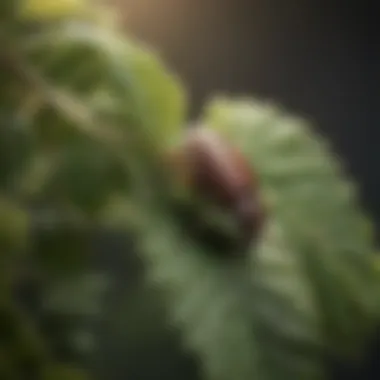Bush Pest Control: Effective Management Strategies


Intro
Bush pest control presents a unique challenge for homeowners and gardeners. Understanding the intricacies involved in managing pests in bush environments is essential for sustainable landscaping. As pests thrive in these areas, learning to identify, control, and prevent infestations can significantly impact the health of your plants and the balance of the ecosystem around them. This article seeks to unveil effective strategies for managing bush pests, focusing on the need for ecological mindfulness and sustainable practices.
Understanding Pests
In order to establish an effective pest management strategy, one must first comprehend what constitutes a pest in a bush environment.
Definition of Pests
Pests can be defined as organisms that are perceived as troublesome or harmful to plants, animals, or human beings. They can take various forms, including insects, weeds, fungi, and even larger animals. Within bush settings, these pests can disrupt plant growth, threaten biodiversity, and diminish the visual appeal of landscapes.
Importance of Pest Identification
Correct identification of pests is crucial. Not all organisms causing damage are pests; some play essential roles in the ecosystem. For instance, beneficial insects such as ladybugs help control aphid populations. By distinguishing between harmful and helpful species, homeowners can adopt targeted measures that do not inadvertently harm beneficial insects.
"Effective pest control starts with correct identification."
Prevention Techniques
To effectively manage bush pests, preventative techniques play a key role. These practices help in reducing the likelihood of infestations before they start.
Home and Garden Preventative Measures
- Regular Monitoring: Frequent checks for signs of pest activity can catch problems early. Look for unusual spots on leaves or presence of insects.
- Diversity in Plant Selection: Planting various species can disrupt pest life cycles, making it harder for them to establish populations.
- Proper Plant Care: Healthy plants resist pests better. Ensure your bushes have proper sunlight, water, and nutrition.
Seasonal Prevention Tips
- Spring: Inspect new growth for early signs of infestations. Introduce beneficial insects.
- Summer: Maintain soil moisture to prevent stress on plants. Prune dead or damaged limbs.
- Autumn: Clear debris that can harbor pests over winter. Rake leaves regularly.
Eco-Friendly Pest Control Solutions
Modern pest control leans towards environmentally friendly practices. Understanding and implementing sustainable options is key for a balanced approach.
Overview of Sustainable Practices
Sustainable pest control focuses on methods that do not harm the environment. Techniques include using integrated pest management (IPM) which combines biological, cultural, physical, and chemical tools.
Natural Remedies and Their Effectiveness
- Neem Oil: Derived from the seeds of the neem tree, it acts as a repellent and disrupts pest feeding.
- Diatomaceous Earth: A natural abrasive that affects the exoskeleton of insects, providing an effective barrier against pests.
- Garlic Spray: Known for its strong odor, it can deter some insects when applied to affected areas.
Understanding Bush Pests
Bush pests can significantly affect not just the health of plants but the overall ecosystem. Understanding the types and behaviors of these pests is essential for effective management. A thorough knowledge of bush pests leads to early identification and intervention. Homeowners and gardeners who grasp the dynamics at play stand a better chance of preserving their landscapes and even enhancing biodiversity.
Defining Bush Environments
Bush environments typically refer to areas characterized by dense vegetation, often comprising shrubs, trees, and other flora. These environments can be natural, like woodlands, or cultivated for aesthetic or agricultural purposes. When you define a bush environment, you also define the habitat of various pests and beneficial organisms. Knowing the unique features of these ecosystems is crucial in devising strategies for pest control. Factors such as soil type, climate, and plant diversity all influence pest behavior.
Common Types of Bush Pests
Bush environments host a variety of pests that can be harmful to plants.
Leaf-eating Insects
Leaf-eating insects, such as caterpillars and beetles, can quickly denude your plants of foliage. Their key characteristic is their feeding behavior, which targets leaves, often leading to reduced plant vigor and aesthetic deterioration. In this context, understanding these insects is beneficial for developing appropriate management strategies.
The unique feature of leaf-eating insects is their ability to reproduce rapidly under favorable conditions. This can lead to significant infestations. However, they can also attract beneficial species, such as birds, that feed on them. Therefore, the strategy should involve careful monitoring and selective intervention.
Wood-boring Beetles
Wood-boring beetles are another group to consider. They are notorious for causing structural damage by tunneling into trees and shrubs. Their impact is not limited to individual plants; entire stands can be compromised. The most significant characteristic of wood-boring beetles is their hidden life stages, often unnoticed until significant damage has occurred.
Their ability to remain concealed makes monitoring essential. Even though controlling them often requires chemical intervention, understanding their lifecycle can help in timing treatments effectively.


Nematodes
Nematodes are microscopic roundworms present in many soil types. They vary significantly, some living freely in the soil while others are plant parasites. Their key characteristic is their size and invisibility. Some nematodes can be beneficial, helping to break down organic matter and improve soil health.
In terms of pest management, nematodes can act as biological control agents against various soil-dwelling pests. However, certain species can also cause harm to plant roots. Thus, accurately identifying nematodes is vital in pest management practices.
Identification of Pests
Identifying pests is a fundamental component of effective bush pest management. Understanding the various signs of pest presence allows homeowners and gardeners to take timely action, minimizing potential damage to their plants and overall landscape. This process involves recognizing specific indicators that can signal an infestation, which ultimately helps in choosing the right control strategies. Moreover, early detection can often lead to more successful management outcomes, reducing the need for extensive intervention later.
Signs of Pest Infestation
What to Look For
When observing your bushes and plants, certain signs can indicate the presence of pests. Common signs include visible damage to leaves, such as holes, discoloration, or wilting. Additionally, residues like sticky substances, often left by aphids or whiteflies, can also be telltale signs. The presence of unusual growth patterns can also suggest pest activity. For example, a sudden wilting or stunted growth can signal root-feeding insects. Detecting these symptoms early enables proper assessment of pest impact and can influence the management strategy chosen.
- Key characteristics that define what to look for include:
- Foliar damage: holes, spots, or discoloration in leaves.
- Presence of sticky residues or webbing.
- Vegetative abnormalities, indicating deeper issues beneath the surface.
Identifying these aspects makes What to Look For a vital choice in understanding pest dynamics. A unique feature is that many of these signs also overlap with symptoms of other plant stressors, making precise identification crucial. The advantage is that knowing what to assess helps direct attention to treatment methods that can be tailored to the specific pests involved.
Indicators of Specific Pests
Different pests leave distinct signs that can aid in effective identification. For instance, the presence of sawdust around plant bases may indicate wood-boring beetles. Similarly, discolored patches on leaves might reveal issues caused by nematodes. Understanding these indicators enhances the accuracy of pest diagnostics and ensures suitable intervention strategies are sought.
- Characteristics of indicators of specific pests include:
- Unique signs for different pests, such as:
- Wood-boring beetles: sawdust and holes in the bark.
- Leaf-eating insects: visible damage on leaves and clipped edges.
This specificity in Indicators of Specific Pests makes it a beneficial element in pest management. Accurate identification through these signs facilitates effective response strategies tailored to specific issues. The disadvantage lies in the potential for misidentification, which can lead to inappropriate treatment approaches.
Using Traps and Monitors
Types of Traps
Using traps is an effective way to monitor pest populations. Various traps are available, each serving specific pests and environments. Common types include sticky traps, light traps, and bait traps. Sticky traps capture flying insects, providing a clear visual gauge of pest density. Light traps can attract nocturnal pests like moths, while bait traps are effective for detecting ground-dwelling pests. Selecting the appropriate type of trap is essential to ensure an effective monitoring program.
- Key characteristics of different types of traps include:
- Sticky traps: good for visual monitoring.
- Light traps: attract nocturnal pests effectively.
- Bait traps: useful for ground insects that are otherwise hidden.
The unique feature of traps is they can provide not just an insight into pest presence but also help in estimating populations. Understanding their benefits is crucial for monitoring the dynamics of bush pest populations.
Best Practices for Setting Traps
Setting traps correctly maximizes their efficacy in managing pests. A few key best practices include placing traps at strategic locations based on pest activity and ensuring that they are regularly checked. Furthermore, aligning trap size and type with the specific pest being targeted increases success. Maintaining cleanliness around traps is also essential, as debris can deter pests.
- Important best practices for setting traps involve:
- Placement: study pest behavior for optimal location.
- Regular checks: ensure traps remain effective.
- Type matching: select traps tailored to the specific pest population.
The significant feature of best practices is developing a systematic approach that increases the likelihood of effective pest capture. The main advantage is that proactive trapping can lead to early intervention, which is critical in bush pest control.
Identifying pests and using appropriate traps are foundational strategies in effective bush pest management, leading to healthier ecosystems and thriving landscapes.
Ecological Impact of Bush Pests
The ecological impact of bush pests is a critical aspect when discussing pest management strategies. Understanding this impact provides valuable insights into how these pests interact within the ecosystem and affect both plant and animal life. While bush pests can be seen as threats, it is essential to acknowledge their role in maintaining ecological balance. Exploring the dual nature of bush pests emphasizes the need for targeted management strategies that reduce harm while recognizing their contributions to the environment.
Role of Pests in Ecosystems
Beneficial Insects


Beneficial insects play a vital role in the bush ecosystem. They are natural predators to many harmful pests, contributing to pest control without the need for chemical interventions. Common beneficial insects include ladybugs, lacewings, and certain species of wasps. One key characteristic of these insects is their ability to prey on aphids and other detrimental pests, which can devastate plant life if left unchecked.
The presence of beneficial insects helps in maintaining a healthier ecosystem. They not only control pest populations but also promote biodiversity. This diversity enhances ecosystem resilience, making it less susceptible to invasive species and diseases. However, it is crucial to ensure that pest management practices do not inadvertently harm these insect populations, as their decline could lead to pest population explosions.
Impact on Biodiversity
The impact of bush pests on biodiversity cannot be overstated. These pests are intertwined with the natural selection processes that shape ecosystems. A certain level of pest presence can provide food sources for larger animals, thus supporting higher trophic levels. Moreover, pests often contribute to soil health and plant diversity through their interactions.
Nonetheless, when certain pest populations overwhelm, the potential extinction of native plant and animal species increases. This loss can lead to decreased genetic diversity and disrupt the intricate web of life. Therefore, understanding the dynamic relationship between bush pests and biodiversity is paramount in forming effective pest management policies.
Potential Damage to Flora and Fauna
Pests pose distinct threats to plant health and wildlife. They can cause direct damage to flora by feeding on leaves, stems, and roots, weakening plants and increasing vulnerability to diseases. Furthermore, the activity of wood-boring beetles can lead to structural damage in trees, affecting both aesthetics and health of forested areas.
Indirectly, damaged plants struggle to provide habitat and food for local fauna, disrupting the entire food chain. For example, if leaf-eating insects proliferate unchecked, birds and other insectivorous animals may face food shortages. This cascade effect can destabilize populations across various species, leading to ecosystem decline.
Strategies for Control
The management of bush pests involves various strategies that aim to mitigate their impact on ecosystems. Effective control strategies are crucial for maintaining healthy landscapes while preventing pest infestations from becoming overwhelming. Each method of control highlights its unique benefits and considerations, making them adaptable for different situations. Homeowners and gardeners must evaluate these strategies to choose what best suits their needs.
Cultural Control Methods
Cultural control methods focus on altering practices to manage pest problems effectively. This involves integrating specific techniques and practices that help reduce pest populations.
Plant Selection and Arrangement
Plant selection and arrangement play vital roles in pest control by choosing plants that naturally deter pests or attract beneficial insects. Selecting native plants that thrive in local conditions can lead to healthier gardens less prone to infestations. One key characteristic of this approach is its encouragement of biodiversity; more types of plants often mean more natural pest control. A major advantage is that it minimizes reliance on chemical solutions, promoting an eco-friendly garden atmosphere. However, specific plant arrangements may require additional planning to maximize their efficacy, which could be seen as a disadvantage for inexperienced gardeners.
Crop Rotation Techniques
Crop rotation techniques contribute significantly to managing soil health and pest populations. By alternating the type of crops planted in a specific location, pests that thrive on certain plants find their food source diminished. This practice also helps prevent soil depletion. A crucial aspect of crop rotation is its flexibility, allowing gardeners to adapt based on pest identification and soil conditions. A potential downside is the increased need for planning as the rotation needs to be thoughtfully scheduled to align with growing seasons. Despite this, crop rotation remains a well-regarded method in sustainable agricultural practices.
Biological Control Solutions
Biological control solutions involve using living organisms to control pest populations. This strategy emphasizes natural ecosystems to maintain healthy gardens through the balance of species interactions.
Natural Predators
Natural predators are organisms that prey on pests, effectively reducing their populations. Introducing beneficial insects like ladybugs or lacewings into a garden can help manage aphid populations, for example. The key characteristic of natural predators is their self-sustaining nature, as these cycle naturally through ecosystems. This method is often viewed as beneficial due to its minimal impact on the environment. However, it requires careful selection and monitoring to ensure that these predators do not become pests themselves.
Microbial Control Agents
Microbial control agents utilize microorganisms such as bacteria and fungi to suppress pest populations. Notably, Bacillus thuringiensis (Bt) is commonly used to control caterpillars without harming beneficial insects. The primary advantage of microbial solutions is their specificity; these agents typically target specific pests, which reduces collateral damage to beneficial species. Nevertheless, microbial agents can take time to show results, raising concerns for gardeners with immediate pest problems.
Chemical Control Considerations
While many prefer to manage pests using non-chemical methods, the reality is that sometimes chemical control is necessary. Careful consideration and knowledge of pesticides ensure responsible usage when needed.
Types of Pesticides
Not all pesticides are created equal. Types of pesticides include insecticides for insects, herbicides for weeds, and fungicides for diseases. Understanding the specific use of these products is crucial to maximizing their effects. The key characteristic of modern pesticides is their efficiency; they are designed to target specific pests with minimal application. However, the downside includes potential resistance development in pest populations and risks to non-target species, including humans.
Application Guidelines
Application guidelines dictate how and when pesticides should be used effectively to control pests while minimizing risks. Proper timing and application technique can significantly enhance efficacy and reduce negative impacts on surrounding ecosystems. For instance, applying pesticides during calm weather can prevent drift and reduce exposure to beneficial insects. However, such detailed guidelines can be challenging for homeowners to follow without proper understanding, making education in this area essential.
Pesticides must be seen as a last resort and should be used with caution to protect both the environment and beneficial organisms.
Through understanding these strategies, homeowners can develop integrated pest management plans that effectively address bush pest issues while considering ecological health. Each method has its merits and challenges, and a comprehensive approach often yields the best results.
Preventive Measures
Preventive measures play a critical role in managing bush pests effectively. Proper planning and strategic execution can greatly reduce pest problems before they escalate. Implementing effective preventive strategies ensures the health of both the ecosystem and the plants within it. Additionally, these measures often require less intervention than corrective actions, leading to lower long-term costs and fewer environmental impacts. Homeowners and gardeners should consider preventive measures as a vital part of their pest management plan.
Designing Pest-resistant Landscapes


Understanding Local Ecosystems
Understanding local ecosystems is fundamental for pest management in bush environments. Each ecosystem possesses unique characteristics that influence pest presence and plant health. Recognizing these attributes helps in choosing suitable plants that are native or well-adapted, creating a resilient landscape.
By planting species that thrive in specific conditions, one can reduce stress on plants, enhancing their resistance to pests. For instance, local plant species usually have natural defenses against region-specific pests. Such an approach is not only environmentally friendly but also promotes biodiversity, ensuring a balanced ecosystem. Homeowners can benefit significantly from this knowledge, as it leads to lower maintenance and reduced pest activity.
Integration of Companion Planting
Integration of companion planting is another powerful strategy in bush pest management. This method involves pairing plants that may enhance each other’s growth and provide mutual pest protection.
One key characteristic of companion planting is its ability to deter harmful insects naturally. For example, planting marigolds alongside vegetables can repel nematodes and other garden pests. This technique is environmentally sustainable, promoting a more robust ecosystem without relying heavily on chemical insecticides.
However, a potential disadvantage is the need for research on compatibility among species. Not all combinations yield favorable results, thus necessitating careful planning. Nevertheless, the potential benefits of enhanced growth and reduced pest problems make companion planting a valuable tool in landscape design.
Regular Monitoring and Maintenance
Regular monitoring and maintenance are essential components of pest management. Keeping a consistent watch over your garden helps in early detection of any developing pest issues. Observational strategies include routine inspections of plants to identify any signs of stress or pest activity, such as discoloration or leaf drop.
Aside from inspections, maintenance practices can further prevent pest infestations. This includes proper watering, adequate spacing of plants, and regular trimming to remove infested parts. Maintaining healthy soil through organic matter addition also enhances plant resilience.
Adopting these regular practices makes it easier to manage bush pests and contributes positively to long-term landscape health.
Proper monitoring allows you to catch pest problems early, leading to easier and more effective management.
Legal and Environmental Considerations
Understanding legal and environmental considerations in bush pest control is vital for effective management. This section helps homeowners navigate the complex landscape of regulations while ensuring sustainable practices. Eco-friendly practices not only preserve local habitats but also protect human health. It is important to be knowledgeable about regulations governing pesticide use and methods that minimize ecological disruption.
Regulation of Pesticide Use
Understanding Local Laws
Understanding local laws regarding pesticide use is essential. Different regions have distinct regulations that may limit what products can be used and how they are applied. These laws are designed to maintain environmental integrity and protect public health. A key characteristic of understanding local laws is the ability to prevent legal repercussions by using compliant practices. Not adhering to these regulations can result in fines or other penalties for homeowners. Therefore, knowing the specific products and methods allowed in one's area is a beneficial choice for effective pest management.
Moreover, proper adherence to local pesticide laws can enhance community trust. Homeowners demonstrate responsibility and care for the surrounding environment through compliance. However, the complexity of these laws can be a challenge for many, necessitating careful research and sometimes expert consultation.
Implications for Homeowners
Implications for homeowners regarding pesticide use cannot be overstated. Understanding and following pesticide regulations directly affects the safety of individuals and family members. A key aspect of these implications is the awareness that improper use can lead to health risks. Homeowners may face significant consequences if they ignore these guidelines, including ecological damage that impacts their gardens and local wildlife.
The unique feature of these implications is that homeowners are encouraged to adopt safer practices, leading to greater sustainability in pest management. Embracing organic methods or integrated pest management can yield long-term benefits. While there may be advantages to using chemical remedies for immediate effects, balancing these with the long-term health of the environment is crucial. Therefore, homeowners should regard these implications as both a responsibility and an opportunity to contribute positively to their ecosystem.
Sustainability in Pest Management
Sustainability in pest management is a guiding principle for modern practices. Incorporating sustainable approaches ensures that pest control methods do not leave lasting negative impacts on the environment. Utilizing natural methods, such as introducing beneficial insects, can promote a healthy ecosystem.
Sustainable pest management prioritizes methods that are both effective and low-impact. This may include integrating crop rotation, selecting pest-resistant plant varieties, and employing safe chemical alternatives only when necessary. All these strategies contribute to a holistic approach, focusing on balance rather than eradication.
The goal is to manage bush pests effectively while preserving the local environment for future generations. Homeowners are encouraged to explore resources and join local community efforts aimed at promoting sustainability in pest control practices. This collective effort leads to more resilient ecosystems and healthier living spaces.
Epilogue: Future of Bush Pest Management
The future of bush pest management is a pivotal area of focus. Its importance lies in the evolution of strategies that address the challenges posed by pests while prioritizing environmental sustainability. Integrating advanced technologies and innovative practices can lead to more effective pest control methods. As we look toward the future, it is essential to balance efficiency with ecological responsibility, ensuring that our actions today do not compromise the health of our ecosystems.
Emerging Trends and Technologies
Advancements in Biological Controls
Biological controls are showing significant promise in bush pest management. This approach utilizes natural organisms to suppress pest populations. A key characteristic is its reliance on predators, parasites, or pathogens that specifically target pest species. This makes biological controls an appealing choice for ecologically conscious homeowners and gardeners. One unique feature of biological controls is the ability to establish a self-sustaining system, reducing the need for ongoing intervention.
The advantages of this approach include lower environmental impact and reduced risks associated with chemical treatments. However, there are challenges. It may take longer to see results compared to chemical solutions, and effectiveness can vary based on environmental conditions and pest species.
Precision Agriculture Techniques
Precision agriculture techniques are an emerging trend in bush pest management that enhances decision-making in pest control. A key feature is the use of technology and data analytics to apply treatments more efficiently. For example, GPS and remote sensing allow for targeted applications instead of blanket treatments. This tailored approach minimizes waste and protects beneficial organisms in the landscape.
The unique aspect of precision agriculture is the application of real-time data. By continuously monitoring conditions, it enables homeowners to respond promptly to pest threats. While beneficial, the initial investment in technology can be a barrier for some. However, the long-term savings and effectiveness often justify this upfront cost, making precision agriculture a worthwhile consideration.
Final Thoughts on Integrated Pest Management
As the field evolves, staying informed about trends and advancements in pest management is crucial. Borrowing from both traditional practices and modern innovations will allow for a more resilient approach to managing bush pests, ultimately leading to healthier ecosystems.



